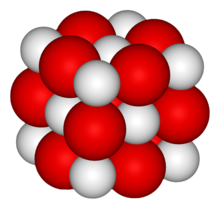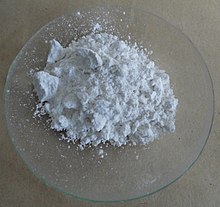Calcium oxide
 | |
 Powder sample of white calcium oxide
| |
| Names | |
|---|---|
| IUPAC name
Calcium oxide
| |
Other names
| |
| Identifiers | |
3D model (
JSmol ) |
|
| ChEBI | |
| ChEMBL | |
| ChemSpider | |
ECHA InfoCard
|
100.013.763 |
| EC Number |
|
| E number | E529 (acidity regulators, ...) |
| 485425 | |
| KEGG | |
PubChem CID
|
|
RTECS number
|
|
| UNII | |
| UN number | 1910 |
CompTox Dashboard (EPA)
|
|
| |
| |
| Properties | |
| CaO | |
| Molar mass | 56.0774 g/mol |
| Appearance | White to pale yellow/brown powder |
| Odor | Odorless |
| Density | 3.34 g/cm3[1] |
| Melting point | 2,613 °C (4,735 °F; 2,886 K)[1] |
| Boiling point | 2,850 °C (5,160 °F; 3,120 K) (100 hPa)[2]
|
| Reacts to form calcium hydroxide | |
| Solubility in Methanol | Insoluble (also in diethyl ether, octanol) |
| Acidity (pKa) | 12.8 |
| −15.0×10−6 cm3/mol | |
| Structure | |
| Cubic, cF8 | |
| Thermochemistry | |
Std molar
entropy (S⦵298) |
40 J·mol−1·K−1[3] |
Std enthalpy of (ΔfH⦵298)formation |
−635 kJ·mol−1[3] |
| Pharmacology | |
QP53AX18 (WHO )
| |
| Hazards | |
| GHS labelling: | |
 
| |
| Danger | |
| H302, H314, H315, H335 | |
| P260, P261, P264, P270, P271, P280, P301+P312, P301+P330+P331, P302+P352, P303+P361+P353, P304+P340, P305+P351+P338, P310, P312, P321, P330, P332+P313, P362, P363, P403+P233, P405, P501 | |
| NFPA 704 (fire diamond) | |
| Flash point | Non-flammable[4] |
| NIOSH (US health exposure limits): | |
PEL (Permissible)
|
TWA 5 mg/m3[4] |
REL (Recommended)
|
TWA 2 mg/m3[4] |
IDLH (Immediate danger) |
25 mg/m3[4] |
| Safety data sheet (SDS) | ICSC 0409 |
| Related compounds | |
Other anions
|
Calcium sulfide Calcium hydroxide Calcium selenide Calcium telluride |
Other cations
|
Beryllium oxide Magnesium oxide Strontium oxide Barium oxide Radium oxide |
Except where otherwise noted, data are given for materials in their standard state (at 25 °C [77 °F], 100 kPa).
| |
Calcium oxide (
Quicklime is relatively inexpensive. Both it and the chemical derivative calcium hydroxide (of which quicklime is the base anhydride) are important commodity chemicals.
Preparation
Calcium oxide is usually made by the
- CaCO3(s) → CaO(s) + CO2(g)
The quicklime is not stable and, when cooled, will spontaneously react with CO2 from the air until, after enough time, it will be completely converted back to calcium carbonate unless slaked with water to set as lime plaster or lime mortar.
Annual worldwide production of quicklime is around 283 million tonnes. China is by far the world's largest producer, with a total of around 170 million tonnes per year. The United States is the next largest, with around 20 million tonnes per year.[9]
Approximately 1.8 t of limestone is required per 1.0 t of quicklime. Quicklime has a high affinity for water and is a more efficient desiccant than silica gel. The reaction of quicklime with water is associated with an increase in volume by a factor of at least 2.5.[10]
Uses
- The major use of quicklime is in the
- Ground quicklime is used in the production of aerated concrete such as blocks with densities of ca. 0.6–1.0 g/cm3 (9.8–16.4 g/cu in).[10]
- Quicklime and hydrated lime can considerably increase the load carrying capacity of clay-containing soils. They do this by reacting with finely divided silica and alumina to produce calcium silicates and aluminates, which possess cementing properties.[10]
- Small quantities of quicklime are used in other processes; e.g., the production of glass, calcium aluminate cement, and organic chemicals.[10]
- Heat: Quicklime releases thermal energy by the formation of the hydrate, calcium hydroxide, by the following equation:[11]
- CaO (s) + H2O (l) ⇌ Ca(OH)2 (aq) (ΔHr = −63.7 kJ/mol of CaO)
- As it hydrates, an exothermic reaction results and the solid puffs up. The hydrate can be reconverted to quicklime by removing the water by heating it to redness to reverse the hydration reaction. One litre of water combines with approximately 3.1 kilograms (6.8 lb) of quicklime to give calcium hydroxide plus 3.54 self-heating can, cooking, and heating water without open flames. Several companies sell cooking kits using this heating method.[12]
- It is known as a E529.
- Light: When quicklime is heated to 2,400 °C (4,350 °F), it emits an intense glow. This form of illumination is known as a limelight, and was used broadly in theatrical productions before the invention of electric lighting.[14]
- Cement: Calcium oxide is a key ingredient for the process of making cement.
- As a cheap and widely available alkali. About 50% of the total quicklime production is converted to hydrated lime are used in the treatment of drinking water.[10]
- Petroleum industry: Water detection pastes contain a mix of calcium oxide and phenolphthalein. Should this paste come into contact with water in a fuel storage tank, the CaO reacts with the water to form calcium hydroxide. Calcium hydroxide has a high enough pH to turn the phenolphthalein a vivid purplish-pink color, thus indicating the presence of water.
- Paper: Calcium oxide is used to regenerate sodium hydroxide from sodium carbonate in the chemical recovery at Kraft pulp mills.
- Plaster: There is archeological evidence that Pre-Pottery Neolithic B humans used limestone-based plaster for flooring and other uses.[15][16][17] Such Lime-ash floor remained in use until the late nineteenth century.
- Chemical or power production: Solid sprays or slurries of calcium oxide can be used to remove sulfur dioxide from exhaust streams in a process called flue-gas desulfurization.
- Carbon capture and storage: Calcium oxide can be used to capture carbon dioxide from flue gases in a process called calcium looping.
- Mining: Compressed lime cartridges exploit the exothermic properties of quicklime to break rock. A shot hole is drilled into the rock in the usual way and a sealed cartridge of quicklime is placed within and tamped. A quantity of water is then injected into the cartridge and the resulting release of steam, together with the greater volume of the residual hydrated solid, breaks the rock apart. The method does not work if the rock is particularly hard.[18][19][20]
- Disposal of corpses: Historically, it was mistakenly believed that quicklime was efficacious in accelerating the decomposition of corpses. The application of quicklime can, in fact, promote preservation. Quicklime can aid in eradicating the stench of decomposition, which may have led people to the erroneous conclusion.[21]
- It has been determined that the durability of ancient Roman concrete is attributed in part to the use of quicklime as an ingredient. Combined with hot mixing, the quicklime creates macrosized lime clasts with a characteristically brittle nano-particle architecture. As cracks form in the concrete they preferentially pass through the structurally weaker lime clasts, fracturing them. When water enters these cracks it creates a calcium-saturated solution which can recrystallize as calcium carbonate, quickly filling the crack. [22]
Weapon
In 80 BC, the Roman general
Quicklime is also thought to have been a component of Greek fire. Upon contact with water, quicklime would increase its temperature above 150 °C (302 °F) and ignite the fuel.[25]
Substitutes
Limestone is a substitute for lime in many applications, which include agriculture, fluxing, and sulfur removal. Limestone, which contains less reactive material, is slower to react and may have other disadvantages compared with lime, depending on the application; however, limestone is considerably less expensive than lime. Calcined gypsum is an alternative material in industrial plasters and mortars. Cement, cement kiln dust, fly ash, and lime kiln dust are potential substitutes for some construction uses of lime. Magnesium hydroxide is a substitute for lime in pH control, and magnesium oxide is a substitute for dolomitic lime as a flux in steelmaking.[28]
Safety
Because of vigorous reaction of quicklime with water, quicklime causes severe irritation when inhaled or placed in contact with moist skin or eyes. Inhalation may cause coughing, sneezing, and labored breathing. It may then evolve into burns with perforation of the nasal septum, abdominal pain, nausea and vomiting. Although quicklime is not considered a fire hazard, its reaction with water can release enough heat to ignite combustible materials.
Mineral
Calcium oxide is also a separate mineral species (with the unit formula CaO), named 'Lime'.[30][31] It has an isometric crystal system, and can form a solid solution series with monteponite. The crystal is brittle, pyrometamorphic, and is unstable in moist air, quickly turning into portlandite (Ca(OH)2).[32]
References
- ^ ISBN 1-4398-5511-0.
- ^ Calciumoxid Archived 2013-12-30 at the Wayback Machine. GESTIS database
- ^ ISBN 978-0-618-94690-7.
- ^ a b c d NIOSH Pocket Guide to Chemical Hazards. "#0093". National Institute for Occupational Safety and Health (NIOSH).
- ^ "free lime". DictionaryOfConstruction.com. Archived from the original on 2017-12-09.
- ^ Merck Index of Chemicals and Drugs, 9th edition monograph 1650
- ISBN 978-1-58829-860-7, retrieved 2022-07-26
- ^ "Lime throughout history | Lhoist - Minerals and lime producer". Lhoist.com. Retrieved 10 March 2022.
- U.S. Geological Survey. p. 43.13.
- ^ ISBN 978-3527306732
- ^ Collie, Robert L. "Solar heating system" U.S. patent 3,955,554 issued May 11, 1976
- ^ Gretton, Lel. "Lime power for cooking - medieval pots to 21st century cans". Old & Interesting. Retrieved 13 February 2018.
- ^ "Compound Summary for CID 14778 - Calcium Oxide". PubChem.
- ^ Gray, Theodore (September 2007). "Limelight in the Limelight". Popular Science: 84. Archived from the original on 2008-10-13. Retrieved 2009-03-31.
- ^ Tel Aviv University (August 9, 2012). "Neolithic man: The first lumberjack?". phys.org. Retrieved 2023-02-02.
- S2CID 129562287.
- ^ Connelly, Ashley Nicole (May 2012) Analysis and Interpretation of Neolithic Near Eastern Mortuary Rituals from a Community-Based Perspective Archived 2015-03-09 at the Wayback Machine. Baylor University Thesis, Texas
- ^ Walker, Thomas A (1888). The Severn Tunnel Its Construction and Difficulties. London: Richard Bentley and Son. p. 92.
- ^ "Scientific and Industrial Notes". Manchester Times. Manchester, England: 8. 13 May 1882.
- ^ US Patent 255042, 14 March 1882
- PMID 22030481.
- ^ "Riddle solved: Why was Roman concrete so durable?", MIT News, January 6, 2023
- ^ Plutarch, "Sertorius 17.1–7", Parallel Lives
- ISBN 0-12-745354-7
- ISBN 0-387-95076-1.
- ^ David Hume (1756). History of England. Vol. I.
- ^ Sayers, W. (2006). "The Use of Quicklime in Medieval Naval Warfare". The Mariner's Mirror. Volume 92. Issue 3. pp. 262–269.
- ^ "Lime" (PDF). Prd-wret.s3-us-west-2.amazonaws.com. p. 96. Archived from the original (PDF) on 2021-12-19. Retrieved 2022-03-10.
- ^ Mallinckrodt Baker Inc. - Strategic Services Division (December 8, 1996). "Hazards". ww25.hazard.com. Archived from the original on May 1, 2012. Retrieved 2023-02-02.
{{cite web}}: CS1 maint: unfit URL (link) - ^ "List of Minerals". Ima-mineralogy.org. 21 March 2011.
- S2CID 93706828. Retrieved 9 February 2023.
- ^ "Lime". Mindat.org. Retrieved 10 March 2022.

